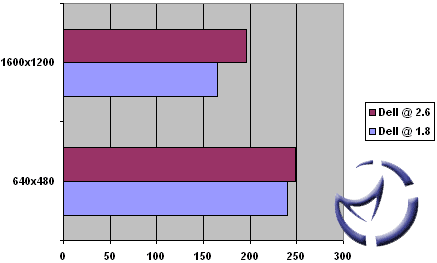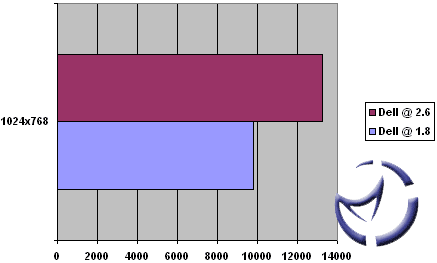|
Game Performance
Although it is pretty much a given that a faster processor will net better game performance, I decided to take a look at how our Dell testbed will do in a couple of benchmarks before and after the PowerLeap upgrade. Equipping our PC with a Radeon 9700, we proceeded to the benchmarks...
Quake 3 Arena

At the lower resolutions, not much has changed, with about 10fps separating the two. At the higher resolutions, where the CPU begins to bottleneck the Radeon 9700, the upgrade shows a substantial improvement in scores.
3D Mark 2001 SE

3D Mark shows a similar trend, where the upgrade adds a nice 3000+ 3D Marks to the overall score.
Overclocking
There are no jumpers, or built-in BIOS on the PL-P4/N, so overclocking will depend greatly on the ability of your motherboard. Overclocking was out of the question for our testbed, so unfortunently, I cannot predict how it will go. I would imagine that if you have a decent overclocking capable Socket 423 motherboard, you shouldn't have any problems.
Final Words
All in all, the Powerleap PL-P4/N looks to be a decent upgrade, but whether or not you should go this route will depend on a number of factors.
1) Future Growth: Assuming your other choice would be a new motherboard, it seems to me that given the current Pentium 4 situation, a new motherboard with native 478 support would present a more flexible upgrade path in the future. Although the i850 chipset is still viable, as our benchmarks have shown, it does lack items such as AGP8x, Hyper-Threading, Serial ATA, and a 533FSB. In any case, there are plenty of good Socket 423 motherboards out there that will benefit from the upgrade. Just be sure to refer to PowerLeap's to be sure it'll work for you.
2) Economics: Right now, a Pentium 4 2.4A will run you about 230$, whether you go with the PowerLeap or not. The PL-P4/N we've reviewed costs 50$, whereas an Abit i845PE will cost about 150$. Obviously, we are using this example as an assumption that you have a Socket 423 motherboard. Assuming that is the case, it's obvious which way is the cheaper upgrade path. Keep in mind that if you have an i850, you can keep your ram. Buying a new motherboard will almost guarantee you'll need new ram to go with it.
3) Time and Installation: I will bet most enthusiasts can easily make the time to overhaul their PC and add a new motherboard. IT Managers, in most cases, have neither the time, nor the budget. Believe me, I know exactly what I'm talking about. Time to upgrade with a PowerLeap kit took no longer than 10 minutes, with no reformatting or installing new drivers.
You'll need to weigh the pros and cons, depending on which catagory you fall under. The particular kit we've reviewed today will only apply if you own a Socket 423 motherboard. You'll be surprised, but a great deal of Pentium 4s in the market place probably fall into this group. My particular company invested heavily on Pentium 4s when they were first released, despite my warnings against it, but now upgrading them can be cheaper than scrapping them for new systems. PowerLeap also offers kits for older computer platforms, making it an economical choice for upgrading the receptionist's PC, or your mom's.
As most enthusiasts already know, a fast CPU alone doesn't make for a fast PC setup. You'll still need to address other areas such as ram, hard drives, video cards and optical drives. The PL-P4/N will extend the longevity of any Socket 423 motherboard though (especially if you have a full featured one), leaving you with the money to look at other areas that need upgrading before replacing your motherboard.
Pros:
Cheap upgrade costs
Performs very well (using an i850)
Easy installation
Cons:
Lack of Northwood "B" support
Does not future-proof your motherboard
Bottom Line: In terms of performance, the upgraded Dell performed competitively against our Shuttle XPC. Ultimately, the newer platform did win the majority of the benchmarks, but the PowerLeap kit wins in terms of price vs performance.

Agree? Disagree? Discuss it in our forums
Previous Page - Performance Continued
Home
|
